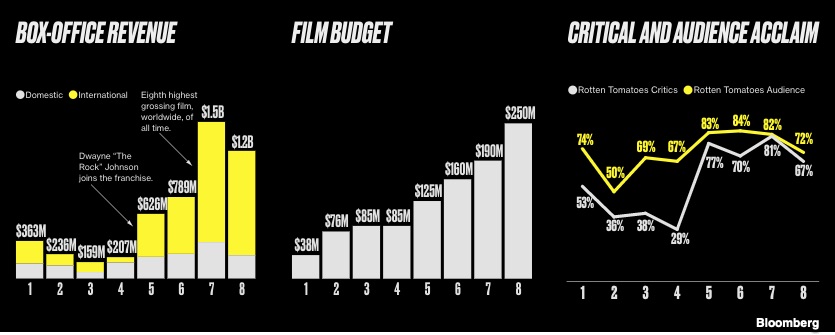
Plastic Straw Ban Surprises
August 7, 2019
When Netflix Became the Designated Survivor
August 9, 2019We know that movie metrics matter. However, what we count depends on the film. In the Fast & Furious film franchise, the stars care most about their fight statistics.
For those of you like me who have not seen all (or even one) of the nine Fast & Furious films, its stars include Vin Diesel, Jason Stratham, and Dwayne “The Rock” Johnson. With Diesel (Dominic Toretto) as the street racer, Stratham (Deckard Shaw), a former British special forces agent, and Johnson (Luke Hobbs), a “sweaty” lawman, each wants never to lose a fight. Vin Diesel even suggested that observers keep track of roundhouse kicks, body slams, and head butts so he could be sure he was getting “pummeled evenly.” It turned out that a count was impossible.
However, the concern remained. Eight seconds after Vin Diesel got shoved through a wall, so too was Dwayne Johnson. When the script required that Dwayne Johnson lay on the ground near Vin Diesel’s feet, Johnson “insisted” that he sit up instead.
You can see the big picture. The fight choreography is orchestrated so that no one looks like a “loser” or a wimp.
Why? It’s all about their branding.
Movie Star Brands
Bloomberg gathered statistics from past Fast & Furious films that reflect the stars’ brands.
Hobbs (white) represents Dwayne Johnson and Shaw (yellow) is Jason Stratham:
Another metric, enemies defeated, again conveys the macho brand:
Although Hobbs smiles more, he also makes more threats:

A 1997 paper tested star power and emerged with the conclusions we would expect. Researchers wanted to see how study participants responded when offered the same film with and without a star. You can see that stars matter:
Then they asked why stars matter. (The mean is the average; SD is standard deviation.):
The Fast & Furious stars’ branding seems to be working. Below, in the graph to the right, audience acclaim tops the critics. I suspect the stars’ brand is the reason:
Our Bottom Line: Competitive Market Structures
Comparing movie star brands, as economists, we can return to competitive market structures. Along the following scale, there are many smaller similar firms at the far left and one single company to the right. In between, the scale becomes increasing less competitive as firms get larger, fewer, and more powerful.
 We could say that, like the largest companies, top movie stars compete as oligopolies. They differentiate themselves through a brand, they have pricing power, and they attract huge audiences.
We could say that, like the largest companies, top movie stars compete as oligopolies. They differentiate themselves through a brand, they have pricing power, and they attract huge audiences.
And with the Fast & Furious crowd, they make sure it has the right punch.
My sources and more: I especially enjoyed the WSJ article on Fast & Furious while Bloomberg’s metrics were the perfect complement. Then, completing the picture, this paper had the behavioral economics side.
![econlifelogotrademarkedwebsitelogo[1]](/wp-content/uploads/2024/05/econlifelogotrademarkedwebsitelogo1.png#100878)









